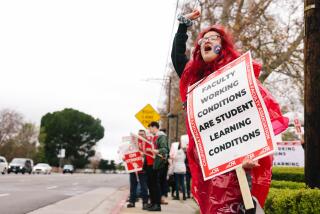USC professors’ book full of surprises for right-wing publisher
Promoters of ideological campaigns just love college professors.
That may sound implausible, but it’s not so hard to understand: Attaching a professor’s name to your cause confers instant credibility and projects objectivity, there are lots of professors around, and their professional work may be so technical and abstruse that no one will know if they really do support your position. As a result, it’s a rare campaign that won’t at one point or another publish a list of faculty members, jangling with PhDs, backing it up.
One wonders if that explains the strange relationship between the right-wing multimillionaire Joe Ricketts and Selahattin and Ayse Imrohoroglu, a Turkish-born husband-and-wife team of economists at the University of Southern California.
Selahattin, 54, and Ayse, 53, are the authors of “The Fiscal Cliff,” a book published by a Ricketts nonprofit called Ending Spending, which normally ranks Washington politicians by their support of a federal spending cap. The organization released the book last week with great fanfare, announcing that it was sending a copy to every congressional and Senate office in Washington, evidently to advance its position that government is too big and taxes are too high.
That’s the point made in the book’s introduction by Brian Baker, the president of Ending Spending.
As it happens, however, the Imrohoroglus’ book doesn’t quite say that. In some respects, their take may be just the opposite: Tax revenues are too low and government can’t be shrunk just like that.
“We’ve got tax revenues at 15% of GDP,” Selahattin Imrohoroglu says. “You’ve got to come back to the ‘80s and ‘90s.” In those decades, tax revenues averaged 19.5% of gross domestic product; were that ratio in place today, it would mean additional revenue for the federal government of more than $700 billion a year, “and then all the gloom and doom projections go away.”
The Imrohoroglus didn’t even learn until their manuscript was finished that it would be published with Baker’s introduction, or for that matter that the publisher would be Ending Spending. And it doesn’t sound as if they were especially overjoyed at the news.
“I read the proposed introduction and said, ‘This is some political statement that has nothing to do with the book,’” Selahattin says. He had to type “Ending Spending” into Google to figure out what it was.
But if the Imrohoroglus found their deal with Ricketts to be full of surprises, Ricketts may have discovered that the manuscript he got wasn’t quite what he counted on either. “Their solution [to the deficit issue] is a little different from what I had expected,” he states in his own introduction.
So are their perceptions of where the problems lie. Ricketts writes that “our country’s debt-to-GDP ratio is a more important indicator of the condition of our overall economy than a price-to-earnings ratio is for a publicly traded company” (the public debt ratio is currently about 70%).
Selahattin Imrohoroglu thinks that may be an overstatement. “Some people think there’s some magical ratio, and if you go above that, the world will end,” he says. “I think the healthiest indicator is the long-run growth rate of the country.”
Once past the introductions by Ricketts and Baker, the text of “The Fiscal Cliff”— with the exception of one very large and very curious error — turns out to be a nuanced, highly technical and not especially ideological analysis of fiscal policy. The text focuses on two key ideas: As Selahattin describes them, these are that the U.S. has to sharply increase its tax revenue (chiefly by eliminating the mortgage deduction and other tax breaks) and get healthcare costs under control.
Perhaps the most interesting question about the book is how Ricketts and the Imrohoroglus came together. Ricketts made his money as founder of what is now TD Ameritrade, the online brokerage. He and his family own the Chicago Cubs.
He’s the founder and financial backer not only of Ending Spending but the Ending Spending Action Fund, a super PAC that supports conservative candidates. Baker says the two entities are “totally distinct,” yet they’re both funded by Ricketts and headed by Baker.
According to federal election reports collected by the Center for Responsive Politics, the PAC spent nearly $900,000 in 2010 trying to defeat Senate Majority Leader Harry Reid (D-Nev.) and contributed more than $150,000 this year to the successful Texas GOP primary campaign of tea party favorite Ted Cruz, who is seeking a Senate seat.
Ricketts also solicited a proposal for an ad campaign attacking President Obama. After it leaked into public view in May, Ricketts disavowed the project, which was built around references to Obama’s relationship with the controversial pastor Jeremiah Wright, a cherished right-wing theme.
The Imrohoroglus, who studied under Nobel economics laureates Edward Prescott and Thomas Sargent at the University of Minnesota, joined USC in 1989 and are currently professors of finance and business economics at its Marshall School of Business. Their oeuvres comprise serious macroeconomic studies dealing with such topics as social insurance and taxation.
When I met Selahattin last week in his USC office — Ayse is out of the country for the summer — I found him an engaging, voluble man with a sure grasp of the complexities of fiscal policy. He told me he and Ayse voted for Obama in 2008, though he hinted that they’ve been disappointed with his political skills. They believe in fiscal stimulus in principle but don’t believe a bigger program is needed in the U.S. He says Social Security’s fiscal problems are negligible and easily addressed by raising payroll taxes and indexing the retirement age to life expectancy.
To this day, he says, he and his wife have never met or spoken with either Ricketts or Baker.
The book offer, he explained, came their way via Mukesh Bajaj, a former USC economist who now runs his own consulting firm and who has worked with Baker in the past. The Imrohoroglus demurred at first — “I said there are better people than us, we are not native speakers, we are geeky scientists” — but Bajaj wore them down by arguing that it was worth communicating what they knew about fiscal policy and promising there would be no interference from Ricketts.
That’s been the case, Imrohoroglu says. On the other hand, the authors did need help putting their thoughts into the vernacular for a general audience. That came from Webster Stone, a writer and film producer associated with Ricketts.
The resulting text, which took about a year to write, has a certain tonal discordance. Passages resonating with the Imrohoroglus’ academic voice and reflecting some of their published work, referring to things like the “Cobb-Douglas production function,” bump up against breezy pronouncements that wouldn’t sound out of place coming from the mouth of, say, a Hollywood scriptwriter.
Then there’s that major glaring error. The book’s closing chapter asserts that “raising tax revenues” will lead to “negative consequences,” such as a reduced gross domestic product. For support, the text cites a projection by the Congressional Budget Office that higher tax rates will lead to a reduction in GDP by as much as 17.6% by 2035.
Here’s the problem: The CBO projection says exactly the opposite. It says the projected 17.6% collapse would result not from raising taxes, but from reducing taxes.
Specifically, the CBO forecasts that retaining the Bush tax cuts scheduled to expire a few months from now would increase the deficit and the federal debt to unsustainable levels, crashing the economy.
Imrohoroglu couldn’t explain how this error got into his text. (Another, more minor error: Although the text describes the CBO projection as applying to GDP, it actually applies to gross national product, or GNP — a related, but larger, economic measurement.)
Yet what’s most intriguing about the mistake is that the erroneous version of the CBO’s projection fits perfectly with Ending Spending’s ideology, which is opposed to tax increases. But the correct version fits more closely with the Imrohoroglus’ viewpoint, which is that the country’s fiscal future depends on boosting tax revenues as a percentage of GDP.
The authors’ findings don’t square with the Ending Spending agenda in other respects. Baker’s introduction complains, for instance, that “our government is too big, spends too much, and does too many things for too many people.”
When I asked Imrohoroglu to respond, he said, “He’s entitled to his opinion.” The authors, by contrast, show that U.S. tax revenues and spending on social benefits both rank lower as a percentage of GDP than those of many other industrial nations, including Britain, Canada, France and Germany. Imrohoroglu says he doesn’t see much leeway for future cuts in discretionary spending in the federal budget.
“The Fiscal Cliff,” as it turns out, is an instructive book, worth reading, just not in the way that Ricketts and Baker seem to have anticipated. For readers interested in really figuring out where the U.S. economy stands today and how to move it forward, the best course may be to focus on what the Imrohoroglus wrote themselves — and toss the rest in the trash.
Michael Hiltzik’s column appears Sundays and Wednesdays. Reach him at mhiltzik@latimes.com, read past columns at latimes.com/hiltzik, check out facebook.com/hiltzik and follow @latimeshiltzik on Twitter.







